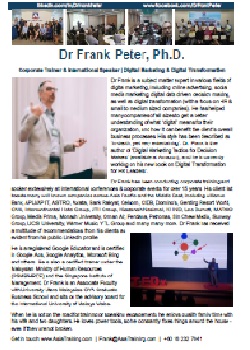Digital Transformation of HR

What is HR digital transformation?
Digital Transformation is not about buying new gadgets or software, or only about implementing digital operations and automation. It is about changing operational processes for the whole organization, including increased employee engagement, the closing of knowledge gaps, and finding better ways of working. HR teams can lead this change by not only transforming HR operations, but also by actively guiding the change in the workforce, and how their work is done.
This is not to be confused with ‘digitization’ and ‘digitalization’, which are often (wrongly) used interchangeably with ‘digital transformation’.
Digitization is simply the conversion of i.e. physical documents into digital ones by scanning them or entering data from a sheet of paper into an online spreadsheet.
Digitalization is the change from ‘analog’ processes into digital ones, i.e. instead of a paper resume being snail mailed it is digitized and sent electronically i.e. via email, or uploaded to the recruiter's website.
Why embark on HR Digital Transformation?
In short: it has to make business sense. Simply digitalizing selected HR tasks without having a bigger picture is actually counterproductive. The goals, tasks, and outcomes have to be in alignment with what your business wants to get out of it.
The aim of digital transformation is for HR to put in place new and innovative systems and processes that will revolutionize how employees experience work culture. HR has to create and establish a working environment that not only increases productivity and efficiency but also improves employee engagement and wellness. Improvements in the processes of hiring, training and performance management will be mirrored by improvements in employee engagement, motivation, and innovation.
Digital transformation is not about technical or IT skills. Instead, it’s all about managing the change of culture and people - including the cultural battle between digital natives and digital immigrants. HR has to play a strategic role in this process by helping employees to adopt a digital mindset, and by hiring future employees who will fit into this new culture.
Digital Transformation and HR challenges
Adjustment to and adoption of the changes that digitalization of company processes require are not easy. HR teams must be prepared to not only face the lack of management buy-in, but also a backlash from employees who struggle to operationalize digital technologies. The challenge is not so much to bridge generation gaps between Gen X, Gen Y & Millennials, but between digital natives and digital immigrants. Adjusting HR practices to a new world requires a lot of restructuring and groundwork.
Another common challenge is ‘thinking too small’. The whole, overall process of a digital transformation of a business is guided by providing better customer experience. Customers want the easiest possible way to get the best products/services, and at the lowest price. Transforming company processes will allow for customers to research & buy online (ease of purchasing), for product development to offer what customers actually want (best products), and for the overall reduction of cost-of-doing-business (resulting in cheaper prices). The transformation of HR processes is just a part of the overall change, and should hence not be seen as a stand-alone endeavor. HR transformation has to always align with the overall business objectives.
Which factors are necessary for a successful digital transformation?
Buy-in: The transformation strategy needs to be able to show from the beginning the benefits that digital transformation can bring to the business, like increased productivity, lower costs, better employees, etc.
Patience: Every stakeholder has to also be aware that there is no ‘silver bullet’ out there that you can buy off the shelf to make it work perfectly from the beginning. Each company is different, each employee is different. The organization has to be able to accept setbacks during the transformation, learn from them and move on.
Investment: Investments includes both money and time. Common costs will include digitizing paper documents onto cloud-based servers, development of (mobile) apps for various aspects of employee engagement, feedback & monitoring, and cloud-based software that holds it all together. Other investments will include the training of employees to learn how to operationalize the new digital technologies.
Data: Actionable data need to be obtained at many points of a business's operation. HR has to be able to collect and analyze relevant data from throughout the organization to improve employee and work-related processes in line with the overall business strategy.
The facets of HR transformation
In contrast to the common multi-year strategy around cloud enterprise resource planning (ERP) frameworks, a digital transformation of HR processes is an ongoing process. Given how fast technology evolves HR teams will never be in a position to say “done, we have finished the process”.
It is important to keep in mind that ‘change’ just for the sake of it is not desirable, if it doesn't make business sense it should not be supported. Also remember that ‘transformation’ is the important word, ‘digital’ just provides the tools to make the process more efficient. It is not about technology, it is about making things better.
It starts out with strategic planning to make the change feasible and frictionless, and the setting-up of a capable digital transformation team. The process itself requires detailed and formalized project planning for change management phases, comprehensive communication with all stakeholders (especially with those at risk of being left behind), constant testing, training, and the agility to adapt to temporary set-backs.
Other important aspects include the development of processes for continuous learning and development, skills development, a robust communication framework, agile performance management, a comprehensive governance framework as well as enterprise IT integration.
Recruiting in the digital era
The process of soliciting, collecting and analyzing employment applications has moved in a completely digital direction. Today, a ‘resume’ is no longer a piece of paper but a collection of all kinds of data about a candidate that can be found online, especially from participation in online communities (Facebook, LinkedIn, etc.). Software is available for HR teams to scout, collate and use these data to assess whether a person will fit the organization, and whether if they have the right skills for the job.
On the flip side, potential candidates can easily evaluate a company thru online channels, i.e. by reading feedback from past & present employees via social media (LinkedIn, Glassdoor). It is crucial for organizations to take their employees seriously, so when they leave the company they can share good feedback which in turn will make it easier for the company to re-hire. It is also important for organizations to brand themselves to potential hires via these same social channels to attract the best talent.
Statistics show that the majority of job seekers will not proceed with a job application if the process cannot be initiated via online channels (company/recruiter website), especially via mobile devices. Companies have to be set-up for this (mobile) trend.
In addition to traditional recruiting HR needs to adapt to the growing trend of Digital Nomads and the Gig Economy.
Adapting to new skill sets
HR digital transformation is not something optional. Past, present and future employees now live a digital life. To best harness, this new trend HR teams must be able to adopt new skill sets to improve their digital capabilities. These skills will include a solid knowledge of the technology involved, being able to manage and analyze statistical data (= people analytics), and being savvy with social media tools. In addition, specific technical skills will be required like developing apps and writing company specific software, which will require HR to include technologists into their traditional teams.
However, as pointed out earlier, technology provides just a set of tools. Good leadership skills are vital in order to effectively drive change management. This will include people skills to ensure that no one is left behind.
The drive for knowledge and continuous learning will influence how well all stakeholders in an organization can operationalize the new technologies. This is arguably the most important aspect of driving digital transformation in an organization. Good news is:: it's a process so it can be learned. If you need help in getting started please check out our hands-on course on Digital Transformation for HR Practitioners.
How to get started with HR digital transformation?
- The process always starts with a clear goal in mind.
- Take stock of what is currently in place, and its shortcomings.
- Get buy-in from all stakeholders.
- Start with the easy changes first.
- Focus on what is important, don’t get carried away.
- Assess your progress by getting feedback from all stakeholders, and learn from it.
- Remember that human touch cannot be replaced by ‘digital’.
Remember: it's a process so it can be learned. If you need help in getting started please check out our hands-on course on Digital Transformation for HR Practitioners.

